What is OpenGL?
OpenGL, developed by
Silicon Graphics, is an advanced
graphical development method originally used on powerful workstations. Now, with
faster and more powerful pc's, OpenGL makes its way onto the Windows95 and WindowsNT
platform for all users, not just developers. There is even OpenGL support in Linux.
And with the announcement between Microsoft
and Silicon Graphics, the future of OpenGL appears to have a future for pc users.
As pc applications with OpenGL support begin to appear to the public, there has
been a twisted side of OpenGL for nearly a year, the 3d action game. With the
release of GLQuake, pc gamers
got their first taste of outstanding 3d graphics that run at exceptional framerates.
And with the release of Quake2 by Id
Software, OpenGL now proves itself as an exceptional graphical API for 3d
action games.
Straight out of the box, Quake2 supports nearly every video board that is capable
of running some various form of OpenGL. The current renderers are:
Default OpenGL - The
rendering mode for video boards that have full OpenGL support in the operating
system. An example of this would be a Windows 95 system using a fully compatible
OpenGL board.
3Dfx OpenGL - OpenGL
support for boards with the 3Dfx chipset. 3Dfx currently has two chipsets which
run 3Dfx OpenGL, the Voodoo and Voodoo Rush chipsets. 3Dfx OpenGL is done by using
the Glide Runtime drivers. By far this is the most popular chipset used in GLQuake
and GLQuake2. Performance in this mode is also exceptional.
PowerVR OpenGL - The
PowerVR PCX2 chipset is a fairly new chipset, yet it has gained the support for
a seperate OpenGL renderer in Quake2. PowerVR boards are internal cards that use
the existing installed graphics adapter, but no daisy-chained monitor hookups
are needed like the 3Dfx Voodoo cards. PowerVR is cheaper, slower, yet it is still
capable of generating the same (or near) quality as that of the 3Dfx boards.
Verite OpenGL - Verite
OpenGL did not ship with Quake2, but support is now available for the Rendition
V1000 and V2x00 chipsets. While OpenGL performance is anything but stellar on
the V1000 boards, the V2100 and V2200 chipsets perform at a satisfactory level.
GLQuake2 Eye Candy
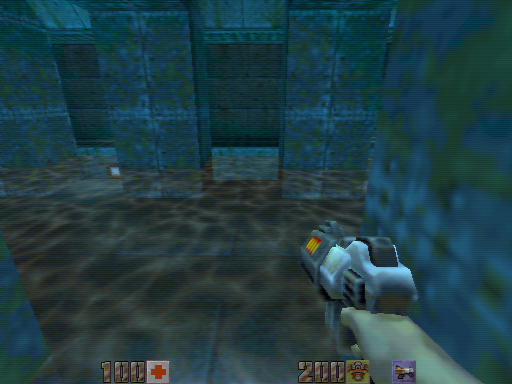
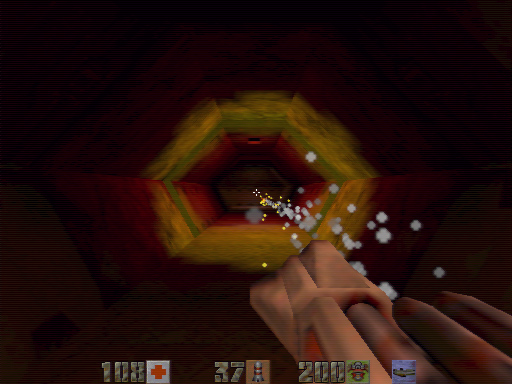 By far the most talked
about effect in GLQuake2 is colored lighting. Instead of basic white lighting
as that of GLQuake, GLQuake2 is capable of different hues of light: red, blue,
green, white, purple, and yellow. This effect gives the player a more realistic
visualization of "being there". When you walk into a deep cavern full of water,
the area gives off a blue shimmer, adding to the overall realism. A room with
lava in it has a reddish-yellow tint to the walls, making the 3d world come alive.
The room actually looks hot, reminding the player it might not be a good idea
to proceed further towards the lava. Weapons like the rocket launcher which travel
a distance before hitting their target give off glorious tints of a yellowish-white
light while they fly, lighting up dark corridors as they scream to their destination
target.
By far the most talked
about effect in GLQuake2 is colored lighting. Instead of basic white lighting
as that of GLQuake, GLQuake2 is capable of different hues of light: red, blue,
green, white, purple, and yellow. This effect gives the player a more realistic
visualization of "being there". When you walk into a deep cavern full of water,
the area gives off a blue shimmer, adding to the overall realism. A room with
lava in it has a reddish-yellow tint to the walls, making the 3d world come alive.
The room actually looks hot, reminding the player it might not be a good idea
to proceed further towards the lava. Weapons like the rocket launcher which travel
a distance before hitting their target give off glorious tints of a yellowish-white
light while they fly, lighting up dark corridors as they scream to their destination
target.
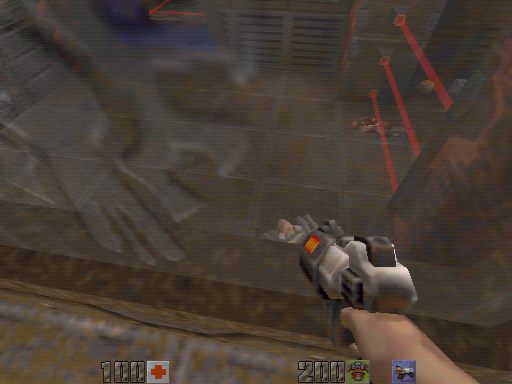
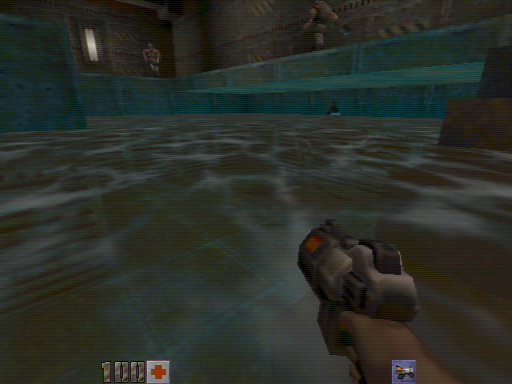 Transparent
surfaces also create a more stunning world. Even though transparent water and
windows are available to non-OpenGL users, the overall effect is magnified when
running in an OpenGL mode. Looking into the water and seeing the fish swim below
the surface and looking through windows and seeing enemies or players on the other
side is a dramatic enhancement to the game. These effects once again let the player
interact with his/her environment.
Transparent
surfaces also create a more stunning world. Even though transparent water and
windows are available to non-OpenGL users, the overall effect is magnified when
running in an OpenGL mode. Looking into the water and seeing the fish swim below
the surface and looking through windows and seeing enemies or players on the other
side is a dramatic enhancement to the game. These effects once again let the player
interact with his/her environment.
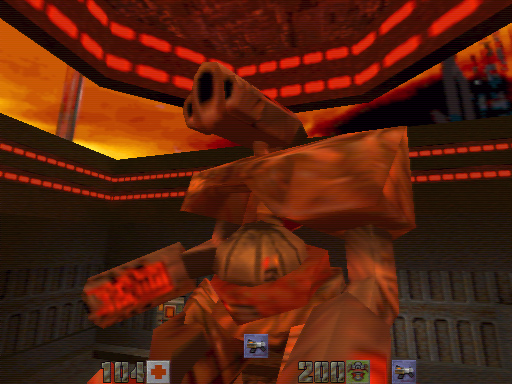
The visual quality of GLQuake2 is what brings the player
into the action. The most noticible thing you will see in GLQuake2 is lack of
pixels. Sure, pixels are there, but you dont see the big blocky, chunky looking
pixels. You see smooth, clean, filtered out pixels. In some ways, GLQuake2 can
be called a super-violent version of Mario64 with colored lighting. :)